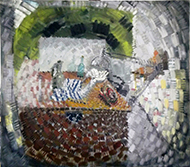Artworks
"To enable us to meaningfully plot our way out of our heads we need to carefully study what they generate" John Jupe
Key visual artists are providing us with invaluable insights
into the nature of human perception, the human umwelt, our relationship with the real (reality) and as light is intrinsically involved in this relationship, some fundamental insights into matter itself (the real). They are all related. Perception is an interplay.
All knowledge has its origins in perception. Leonardo Da Vinci
At a cultural level we can no longer afford to either misunderstand the messages being articulated or fail to formalize and deploy the understandings.

To facilitate this, artists need to be clear about:
- the nature of the undertaking
- what has been achieved over the last few hundred years
- what is required to formalise these insights into a platform capable of supporting further enquiry
- what is required to develop a generic system that can evolve alongside that understanding
- how these insights can be deployed within technology, impacting the structure of digital media, the nature of our communication systems and our instrumentation.
If this doesn’t sound like the intro to a visual art forum then that’s a measure of the misunderstanding that's grown up and the shortfall that our discipline must address and bridge to be taken seriously.

The discipline of Fine Art needs to make itself relevant as a force behind academic and technological development. It must move beyond comment, illustration and conceptual superficiality to make a pertinent contribution to cultural advancement by working with and impacting upon activities taking place in other disciplines.

Visual art deals first hand with perception. This uniquely privileged vantage is a difficult position to hold. The ease and convenience of conceptual word play confines those players to novel illustrative duties that lack perceptual meaning. The discipline needs re-founding.
Art lives from constraints and dies from freedom. Leonardo Da Vinci

We are looking for serious collectors, institutions, art critics and historians who have the means and commitment to assist in the re-habilitation of Fine Art as an academic discipline advancing experiential ontology.


The so-called deformations in visual art are manifesting flashes of perceptual structure. It is these ‘flashes’ that continue to engage and fascinate us on the walls of the world’s leading national galleries.
There is meaning in the aesthetic that almost defies description precisely because it contains new knowledge. The kind of knowledge pertinent to the current shortfall in our understanding of awareness, consciousness and the human umwelt.

Since the 17th century visual art has been at the centre of an evolving and deepening engagement with our perceptual processes. From Chardin through Turner to the Impressionists, through Bonnard, Picasso to Bacon the level of engagement has been intensifying without adequate formal analysis. The experiential ontology has by definition been excluded by the ontology of third party observation ensuring a situation akin to a hall of mirrors developed in the palace of knowledge generation.
Intuitive records manifest our relationship with the real but the understandings that could be developed to advance the situation remain inaccessible, a matter of personal encounter for the artist but lying tantalizingly beyond actualization. Vision-Space has the potential to fundamentally change that dynamic.

Step-by-step, visual artists have taken us behind the curtain of perceptual awareness to acquaint us with the structures and processes driving experiential reality and the human umwelt. The progress towards awareness of perceptual structure can in some senses, be traced by the extent to which this new ‘image’ paradigm has gradually eclipsed the geometry of central perspective and the all-conquering certainty of the ‘pictures’ presented by optical projection. The impact of this ‘instrument’ and the records it delivers and which seem to so conveniently to confirm the veracity of 3rd party objectivity, has been nothing short of bewitching.
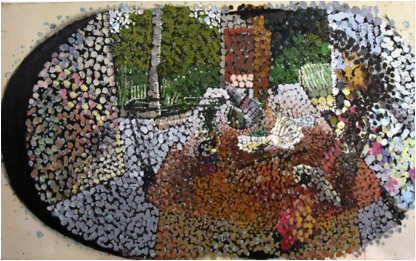
The title of Koestler’s book ‘Sleepwalkers’, describing the dawn of enlightenment while quietly lamenting areas that the process set aside, can also be used here to describe how artists felt their way forwards without apparent strategy but crucially also without reliance on instrumentation. Artists have not let the camera (instrumentation) stand in for them.

It has been largely down to individuals working independently to develop strategies to render visible the cornerstones of experiential reality. By dong so they collectively reveal just how it is that we are embedded in the universe and by default just how our current instrumentation isn’t!
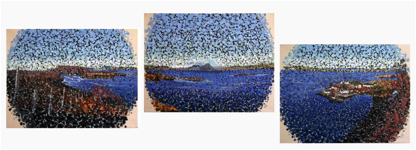
I think we are now in the position to declare these fundamentals within a new form of illusionary space that is based on our perceptual structure. The implications of a new platform are truly profound. The articulation of the illusionary space of perspective and picture space played a pivotal role in the last renaissance. The fundamentals of perceptual structure present the potential to revolutionise all forms of information display, our data capture systems and the way we interact with them. Unsurprisingly, at least for me, key scientists and philosophers have also arrived in the clearing but by riding a different bus. They played detective assembling the shape of a room that they’re not equipped to entre and speculating about its contents. It is the artist that holds the keys. We are however, all attempting to study the same thing.
What lies between us is the formality of ditching 3rd party observation and an unquestioning reliance on the class of instrumentation it has spawned. Science must let go of its platform. We must abandon the physical theories developed using 3rd party objectivity and develop replacements that work in accordance with the human umwelt and what that tells us about the nature of reality and hence the structure of the real. You can’t take us (the perceiver, the sentient being) out of an act of observation. It is meaningless to try as we are embedded in the universe in ways that our instrumentation is not.
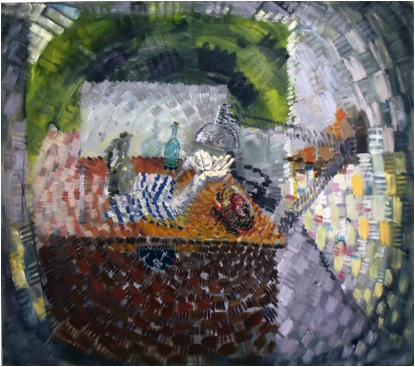
Vision-Space reveals to us not just what’s involved in us addressing arrangements of simple objects, it informs us about what’s involved in an act of observation and how to be objective. It tells us how to address our environment, the universe and the micro realm. We are currently overlooking critical aspects of perceptual structure and how they are generated by us as biological systems. We must not let our instrumentation stand in for us even at remote scales.
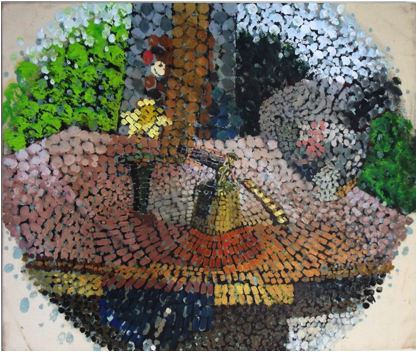
Understanding the issues relating to our relationship with the real will enable us to export that knowledge to better confront remote scales through perceptual technologies.
Visual art will as before play a fundamental role in this transformation, in this Renaissance.
Artworks
There are two sections to the art works library. The first contains works that clearly relate specifically to the Vision-Space story and the second works containing other interests that may use aspects of this system of presentation.
All artworks are for sale
t: 07813688212
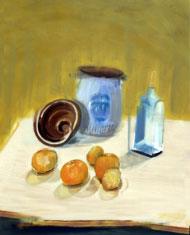
John Jupe :Still life with Oranges
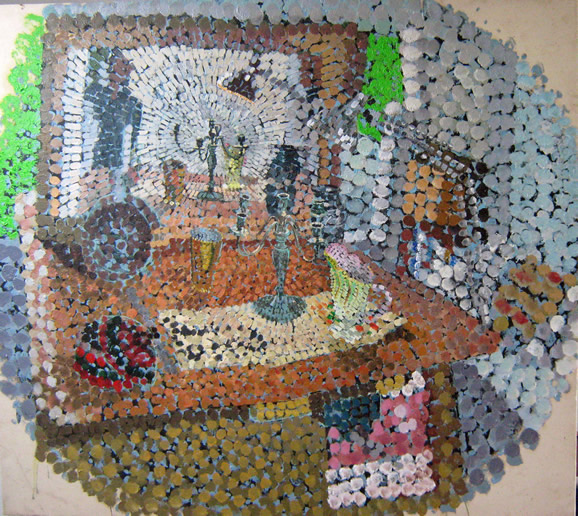
Ecology of visionLibrary
Abstract | Full
Living without pictorial geometry
Abstract | Full
Muller cells & mechanobiology
Abstract | Full
Perceptual condendation in contextual field
Abstract | Full
The Experiential Ontology
Abstract | Full
Retinal processing: A theoretical proposition for retinal detection of a field potential unfolding from the light array to form the basis of spatial and orientation awareness within the phenomenon of vision
Having the Courage of Your Perceptions
Abstract | Full
Replicating our understanding of vision in images
Abstract | Full
PT Use of Vision-Space ERA
SIGGRAPH
Joe Baldwin's evaluation work
Theoretical overview
What does perceptual structure indicate with respect to cultural development, the maintenance of social orders and communication between world-views?
Abstract | Full
